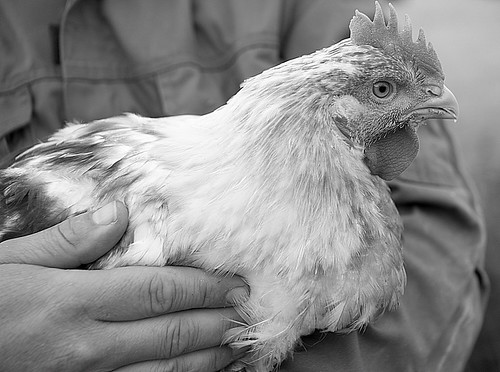From Soil to Table visited Nedre Grini farm at Hærland in the county of Østfold, where Bjørn Ivar Holmen is one of three producers who is breeding Livèche chicken.
From Soil to Table visited Nedre Grini farm at Hærland in the county of Østfold, where Bjørn Ivar Holmen is one of three producers who is breeding Livèche chicken. The other breeders are located at Løken farm and Frøshaug farm. We wanted to have a closer look at this chicken which is allowed to live twice as long as the common, Norwegian chicken available countrywide.
The Livèche chicken weighs about 3 kg when it’s ready for slaughter. Due to the taste of the meat and a residual taste of garden lovage from the fodder they are being fed, this chicken has become popular both among cooks at restaurants and among consumers, in general.
Since the Livèche chicken is only sold as fresh meat, a close cooperation between the 3 farmers who are raising them, is required. This means that they are buying newly born chickens and slaughtering the grown-ups at different times, in order to ensure a steady delivery of chicken meat. When the chickens are sent for slaughter, they are gassed with carbon dioxide, beheaded and hung up like what is done with turkeys. Afterwards, they are cut up and sold as either whole chicken, thigh or chest.
When Bjørn Ingar has sent the chickens to slaughter, the premises where the chickens have resided, has to be cleaned thoroughly and be prepared for reception of another set of tiny chickens, a hybrid called Ross Rowan. It has been time-consuming and costly to develop this slow-growing, meaty chicken, Bjørn Ingar told us. His chickens have an average lifetime of 65 days, while chickens available in supermarkets countrywide live for 28-32 days. The upper limit of chickens bred yearly at Nedre Grini farm amounts to 50.000 chickens, while a conventional chicken breeder has an upper limit of 120.000 chickens.
The fodder which the chickens are eating is prepared at Mølla in Trøgstad, consisting of barley and oats, together with maize and garden lovage. No animal proteins nor fish flour is added to the fodder.The chickens have enough space in which to roam, Bjørn Ivar adds, I see it on their behaviour and their general health.
The chickens seemed to live a good life according to our untrained gazes. Since we don’t know anything about chickens in particular, we just had to trust our senses. They were free to move indoors and they were able to walk inside a netting fence whenever they felt like it. Natural light indoors together with being able to eat and drink whenever they wanted, seemed to give the chickens as good a life as can be expected for domestic animals.
We also touched upon the circumstances of Norwegian farmers. We are very often told how much subsidies farmers receive from the government. How much do you receive in subsidies in relation to the total sales? 5%, Bjørn Ivar replies. If I buy a chicken chest for about 100 Norwegian crowns in the supermarket, how much do you get? 10%, he said. Research and development, nice packaging, the slaughterhouse, the wholesaler, the supermarket and the government takes the remaining 90%.

